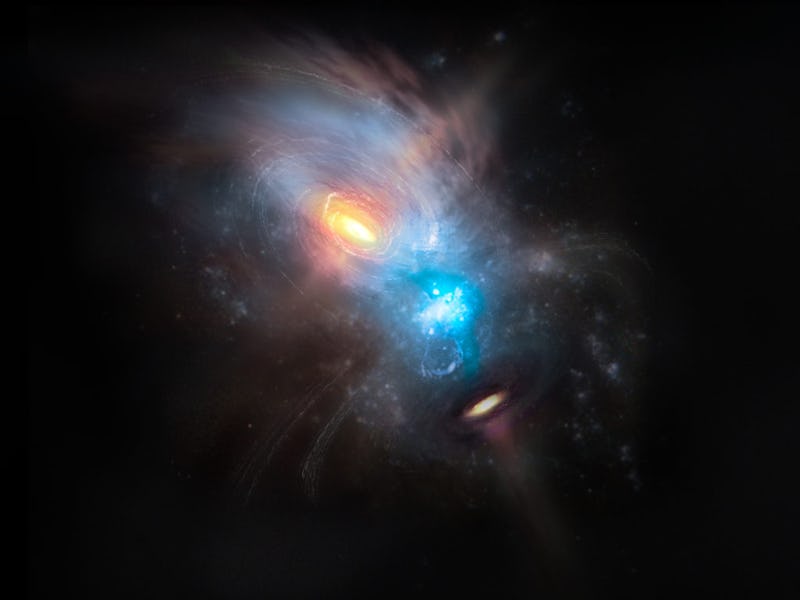Black holes caught in galaxy crash reveal secrets of star-forming gas
"In a few hundred million years, this galaxy will look completely different.”

Astronomers announced this week that they imaged a collision between two galaxies in unprecedented detail. The new image reveals the cold gas structure used to form stars within the merged galaxy — but the gas is also feeding two supermassive black holes, set to merge into one as the galaxies continue their process.
“This galaxy is so complex, that we could never know what is going on inside it without these detailed radio images,” Loreto Barcos-Muñoz of the National Radio Astronomy Observatory in Charlottesville, Virginia, said in a statement. “We now have a better idea of the 3D-structure of the galaxy, which gives us the opportunity to understand how galaxies evolve during the latest stages of an ongoing merger. In a few hundred million years, this galaxy will look completely different.”
The resulting merged galaxy, known as NGC 6240, is located 400 million light-years away from Earth in the Ophiuchus constellation. The galaxy was previously captured by the Hubble Space Telescope. This new image came from the Atacama Large Millimeter/submillimeter Array (ALMA), billed as “the most complex astronomical observatory ever built on Earth.” It uses 66 dish antennas to capture new details of the universe from its base in northern Chile.
The array allowed the team to take a snapshot of the merged galaxy with 10 times greater resolution than had previously been possible. In the resultant images, the star-forming gas shows up as blue, while the red dots are the black holes.
In this image, the ALMA image is shown on top and the Hubble image is shown on the bottom.
“The key to understanding this galaxy system is molecular gas,” Ezequiel Treister of the Pontificia Universidad Católica in Santiago, Chile, said in the statement. “This gas is the fuel that is needed to form stars, but it also feeds the supermassive black holes, which allows them to grow.”
The image reveals new details that challenge previous assumptions about NGC 6240. Scientists had thought that the merged galaxy’s two black holes were much larger — around a billion times the mass of the Sun. But it turns out that the black holes have much more gas than expected orbiting them, which means they are likely only around a few hundred million times the mass of the Sun.
This has big implications for other black holes in the cosmos, as it may be the case that star-forming gas has thrown off estimations of the mass of other black holes by anywhere between five and 90 percent.
Star chart showing the location of the merging galaxy NGC 6240, in the constellation Ophiuchus. NGC 6240 is located about 400 light-years away from Earth.
The gas is also a lot closer to the black hole than originally expected. It seems to form a chaotic stream, with some ejected at speeds of up to 500 kilometers per second. That’s fast enough to get between New York and Los Angeles in under 10 seconds.
“It is located in a very extreme environment,” Medling explained. “We think that it will eventually fall into the black hole, or it will be ejected at high speeds.”
It’s not the first time ALMA has made a fascinating discovery about the universe. In August, the array revealed a huge swirling disk of interstellar gas moving around a supermassive black hole. That black hole was found to have a mass around 2.25 billion times that of the Sun.